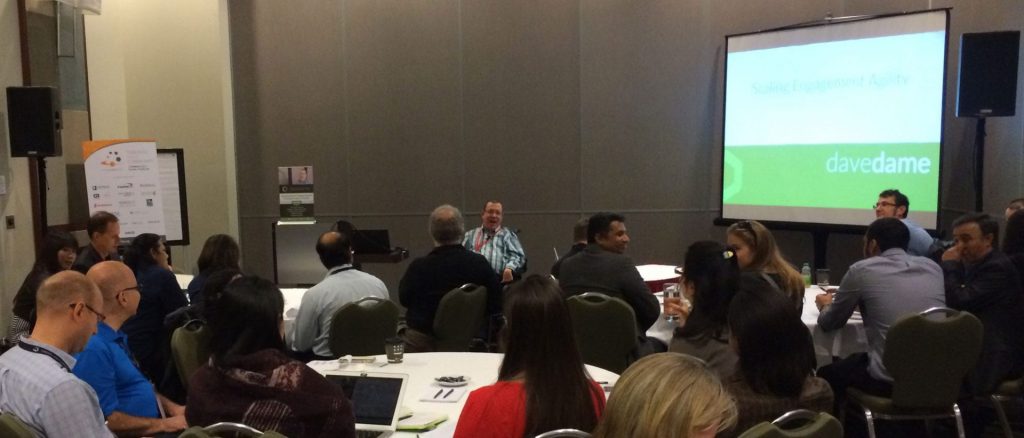Scaling Agility: Real-World Insights
The momentum behind the adoption of Agile methodologies continues to build. Uptake has been growing over 10% year-over-year according to some research. As of 2014, a whopping 94% of organizations claim to be using some form of Agile.

The momentum behind the adoption of Agile methodologies continues to build. Uptake has been growing over 10% year-over-year according to some research. As of 2014, a whopping 94% of organizations claim to be using some form of Agile.
Regardless of the numbers, Agile is the new normal.
At the same time, there’s been a shift toward software defined infrastructure, fueled by the need for IT to enable a more rapid response to the business. Applications and services need to be developed, tested, and pushed to production quicker than ever before. This precipitates the need for IT to adopt a new mindset and a new way of working. Infrastructure leaders require a framework to enable this shift and Agile paradigms are already being tested.
“Agile culture doesn’t just happen – it has to be purposeful.”
– Dave Dame
In the new software centric infrastructure, an Agile approach embeds cross-functional collaboration to rapidly deploy solutions to the business. It increases communication, eliminates silos, promotes transparency, reduces the time to make decisions, and fosters a holistic view across different functions.
Agile adoption within an organization often follows a typical pattern: a small team of Agile enthusiasts “pilot” a project. The team then experiences success and the business case is built. The company then starts to roll out Agile across the department or enterprise. But, when companies start scaling Agile, they run into roadblocks – they struggle with organizational change and are challenged by a status quo business culture . At this point, leaders are often left scratching their heads about how (or if) to move forward.
When it comes to truly embracing Agile – being agile, not just doing agile — adopting the tools and practices are easy but it’s the mindset that is the most difficult to crack.
Leaders need to transform their larger organization by ripping out the traditional hierarchy and systems. It’s a big jump to move from a focus on individuals to teams. You can’t just pay lip service – you have to change the foundation: how you hire, train, measure performance, and define roles.
“While never complete, our transformation has resulted in more rapid and stable product releases, a stronger and more collaborative work environment, and ultimately, a better company that always puts customers and people first.”
– Andrew Wertkin
Agile uplifted traditional software companies by breaking silos between the functions of requirements gathering, design, development and project management. Organizations have benefitted greatly from systems that are more transparent and rapidly deployed from idea to production.
According to Dave Dame, a large scale Agile change agent and Director of Agile and Lean Practices at BlueCat, leaders need to pay attention to people first. “Agile culture doesn’t just happen – it has to be purposeful.” He adds, “People won’t hit their full potential if you don’t support them with true engagement and the right culture. If you’re not creating a culture of excitement, regardless of the processes you use, you won’t see real success.”
Scaling Agile successfully relies on a few guiding principles:
- Maintain a start-up culture
- Keep a focus on the people, not the tools
- Continually share your organization’s vision
- Create a bond with every employee
Further, a few fundamentals will help the transition. The goal is to build a deep and constant relationship with employees. This starts on the first day and continues throughout the employment relationship. And leadership, not surprisingly, is critical.
- Onboard with intent
- Create a consistent sequence of onboarding steps: acquire, kick-off, assimilate, feedback and follow-up
- Embed a customer-driven focus
- Promote Empathy Driven Development, a development approach that relies on team members making decisions based on empathy towards impacted customers
- Promote shared social learning through Lean Coffee, wider company talks and Community of Practice
- Nurture continual change
- Shift from the concept of periodical transformations to an environment of continual change
- Nurture a learning environment
- Embrace the philosophy of “fail fast, fail often” to learn faster
- Master leadership
- Hire and develop coaches, not bosses
- Reward the right behavior
- Create team goals to reinforce collective ownership and accountability
The Agile transformation at BlueCat with Dave Dame at the helm has resulted in immediate benefits. “Agile is one of the hardest things you will do with your organization,” confides Andrew Wertkin, CTO at BlueCat. “However, the effort is well worth it. While never complete, our transformation has resulted in more rapid and stable product releases, a stronger and more collaborative work environment, and ultimately, a better company that always puts customers and people first.”
BlueCat is not only embracing Agile within its walls, it’s also supporting the movement toward a software centric infrastructure world, specifically in the enterprise networking space. BlueCat solutions are architected so that services and APIs are released in a more fluid and rapid continuous delivery stream, thereby supporting clients’ corresponding deliverables to their business.
To help support the movement away from the traditional hardware centric infrastructure world, BlueCat will be releasing a series of blog posts to help guide IT organizations on how to leverage the many benefits of Agile in the new environment of software driven infrastructure.
2https://www.versionone.com/pdf/state-of-agile-development-survey-ninth.pdf
3http://www.ambysoft.com/surveys/agileJanuary2014.html#Results




